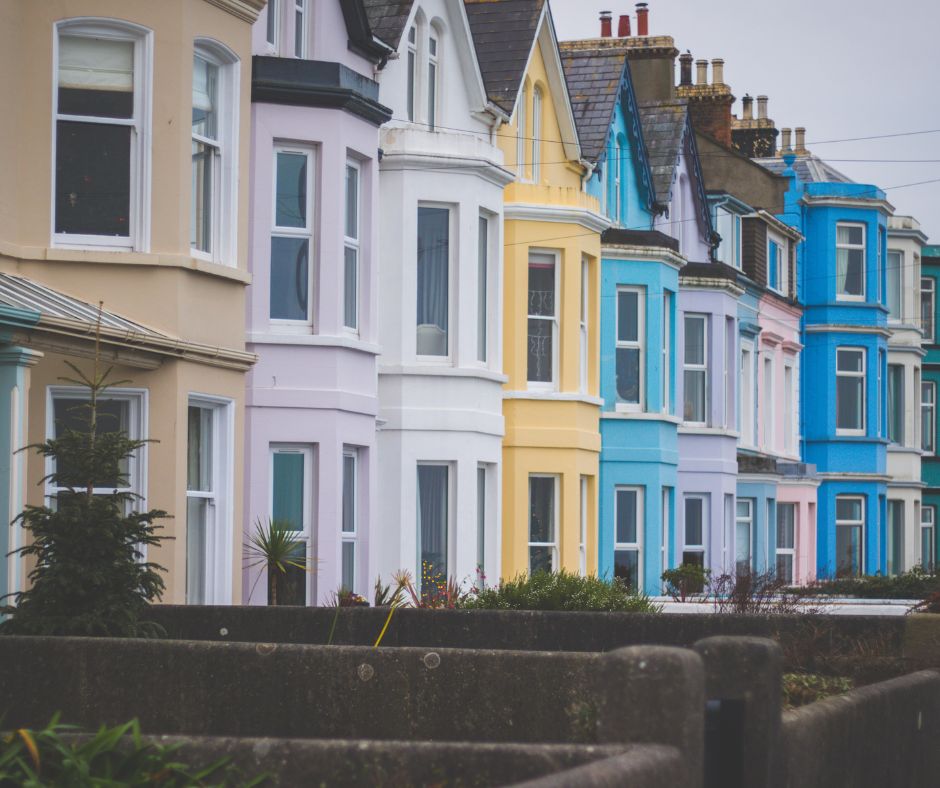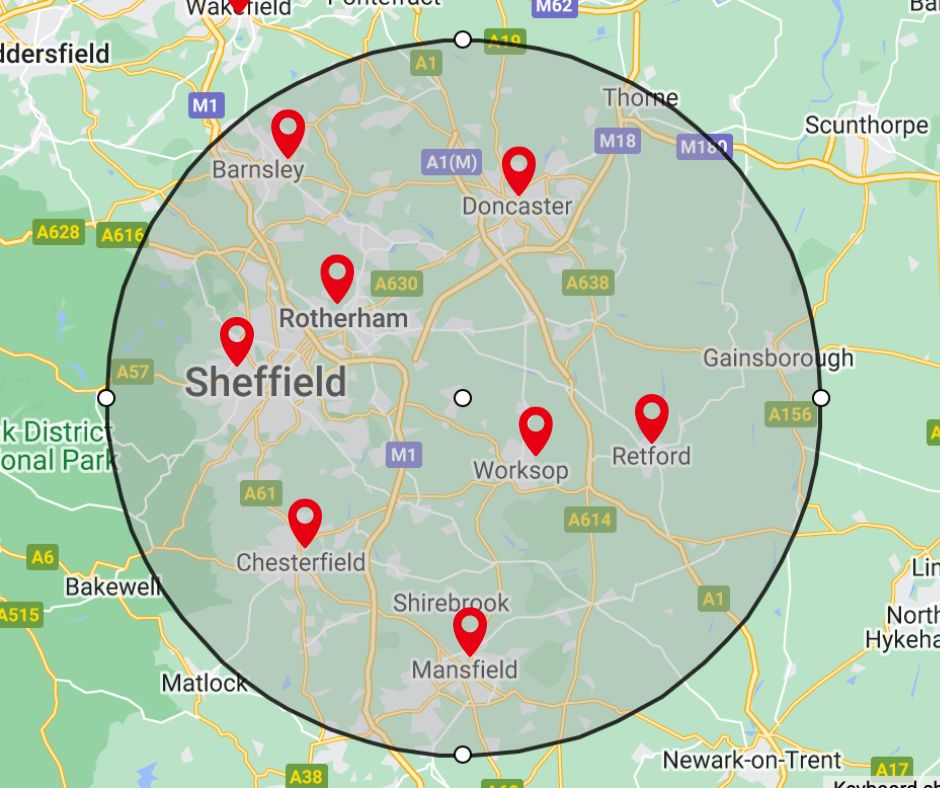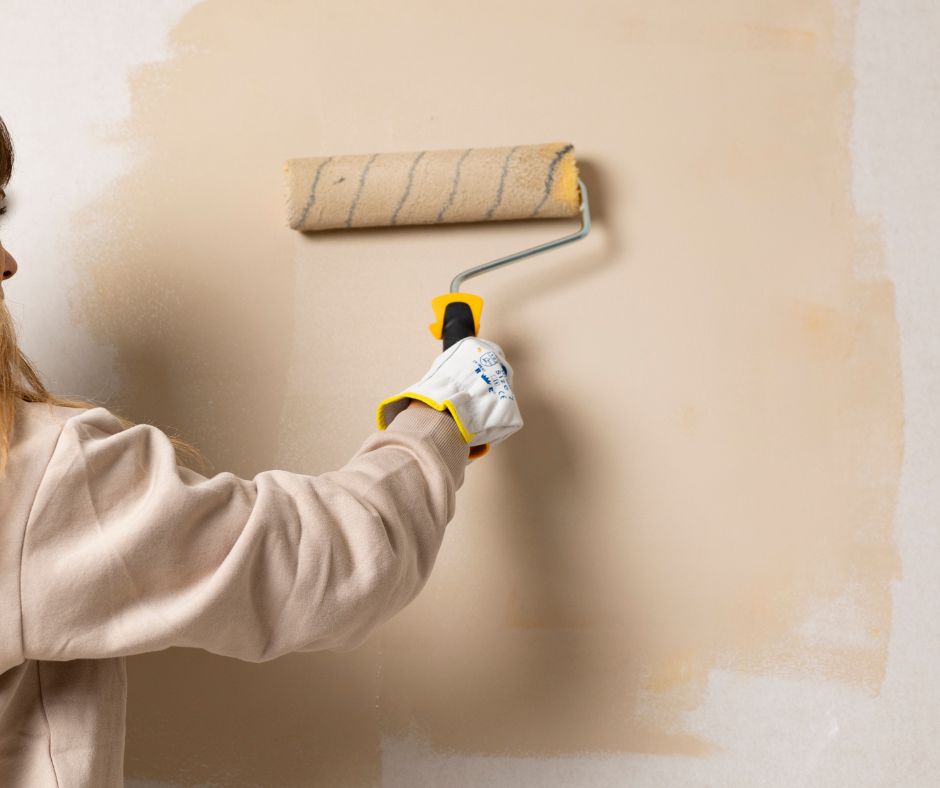Welcome to P3 Plastering’s Comprehensive Guide on Coloured Render. In this article, we’ll walk you through this modern exterior coating, shedding light on its diverse types, benefits, and popular choices.
Whether you’re a homeowner looking to revamp your property or just curious to understand the shades and textures of coloured render, this guide is your go-to resource.
Join us as we delve into the world of coloured render finishes, durability, and the spectrum of colours that define the future of rendering. Ready to make your property stand out? Let’s dive in!
Table of Contents
- What is Coloured Render?
- Benefits of Coloured Render
- Monocouche Coloured Render
- Monocouche Render Colours
- Silicone-Based Coloured Render
- Acrylic or Resin-Based Coloured Render
- Minder-Based Renders
- Coloured Render Options and Finishes
- Popular Colours and Trends
- Considerations and Downsides
- How much does coloured render cost?: Pricing Overview
- Top-Quality Materials, Trusted Techniques
- Frequently Asked Questions about Coloured Render
- Professional Advice and Further Information
- Conclusion: Elevating Your Property with Coloured Render
- Book A Render Evaluation
What is Coloured Render?

Coloured render, often referred to as through coloured render in the industry, stands as a modern marvel in exterior coating solutions. This sophisticated rendering technique involves infusing colour pigments directly into the render during the manufacturing process.
Unlike traditional render, where colour is applied merely as a topcoat, through coloured render ensures that the pigment permeates the entire material. The result is a seamless, lasting colouration that not only enhances the visual appeal of your property but also eliminates the need for periodic repainting, a notable advantage for homeowners seeking low-maintenance solutions.
This innovative approach to rendering introduces a range of benefits beyond its visual appeal. Manufacturers have developed advanced render systems that incorporate polymers, enhancing durability and providing additional weather protection.
For instance, certain silicone-based products include water-repellent technology, effectively shedding water while allowing the property to breathe—a dual functionality that is particularly valuable in maintaining the longevity of the structure.
As we explore the world of coloured render, it’s crucial to understand the distinction it brings compared to conventional rendering methods. While traditional render may necessitate repainting over time, coloured render, with its inherent pigmentation, remains steadfast, embodying both longevity and aesthetic finesse.
It’s not merely a surface treatment but a comprehensive solution that transforms the very fabric of your property’s exterior.
Benefits of Coloured Render
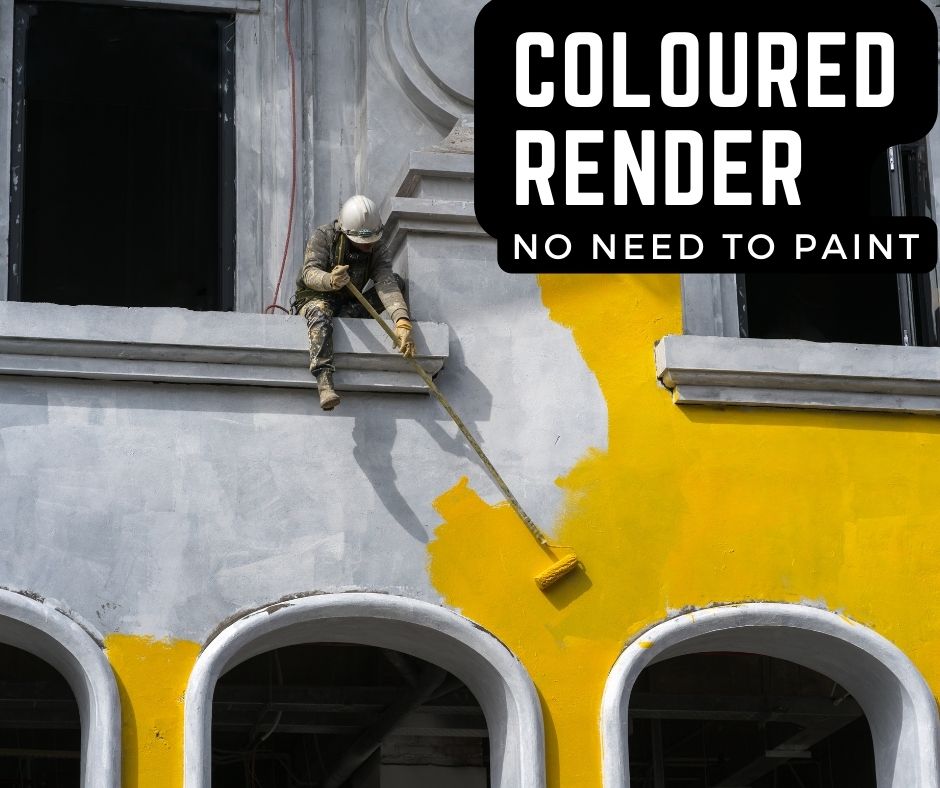
Coloured render brings with it a host of advantages that make it a compelling choice for homeowners and property developers alike. The primary benefit, shared across various types of through coloured renders, lies in their low-maintenance nature.
Unlike traditional renders that may require periodic repainting to maintain their appearance, coloured render retains its vibrant hues without the need for additional coats.
Beyond the convenience of minimal maintenance, through coloured renders are fortified with polymers during manufacturing, enhancing their overall durability. This added resilience translates into a longer lifespan for the render, making it a cost-effective investment over time.
Weather protection is another standout feature of coloured render. Silicone-based renditions, in particular, boast advanced water-repellent technologies. This not only shields the render itself but also ensures that the underlying structure can breathe, preventing issues like dampness.
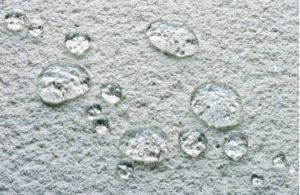
The through coloured nature of these renders provides inherent resistance to algae growth, a common concern in regions with high humidity. The resistance to water penetration also contributes to the prevention of mold and mildew, further promoting a healthier environment for your property.
It’s not just about practicality—coloured render opens up a realm of design possibilities. Whether you opt for the crisp, flat finish of monocouche render or the textured allure of silicone-based render, these options are versatile and can even mimic the appearance of brick or stone.
The extensive colour palette, ranging from subtle tones to bold statements, empowers property owners to express their aesthetic preferences creatively.
In summary, the benefits of coloured render extend beyond visual appeal. They encompass durability, weather resistance, low maintenance, and design versatility—a comprehensive package that not only enhances the external visual appeal of your property but also contributes to its long-term well-being.
As we explore the various types of coloured render, these benefits will become even more pronounced, offering tailored solutions for diverse architectural needs.
Monocouche Coloured Render
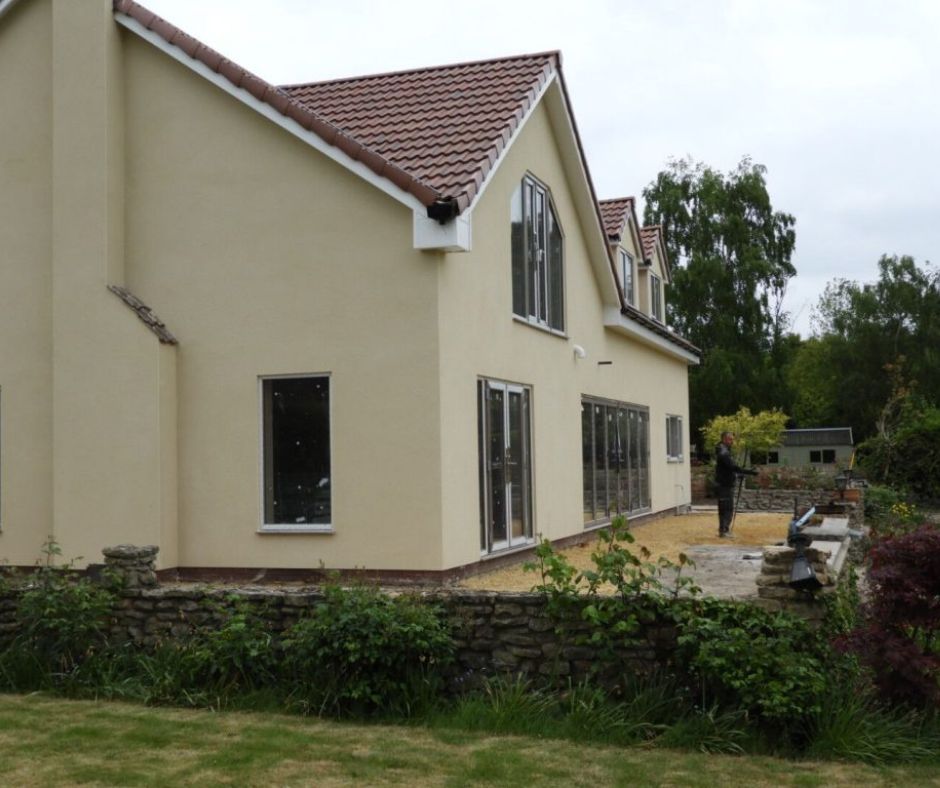
Monocouche coloured render stands out as a distinctive player in the realm of through coloured renders, offering a streamlined and efficient one-coat application process. The term “Monocouche,” derived from the French for “single layer,” aptly describes this cement-based render designed primarily for brick or blockwork surfaces.
Key Characteristics
Application Versatility: Monocouche render can be skillfully applied either by hand or machine, showcasing its adaptability to various application techniques.
Finish Quality: After application, the render is meticulously scraped back to achieve a flat finish that has a pitted look, elevating the visual appeal compared to traditional render methods.
Economic Efficiency: Noteworthy for its economic pricing, monocouche render offers an attractive option for those seeking both quality and affordability.
Design Flexibility: Despite its one-coat nature, monocouche render provides the opportunity for diverse finishes, including options to replicate the appearance of brick or ashlar stone.
Benefits
Low Maintenance: As a through coloured render, monocouche eliminates the need for subsequent painting, ensuring long-lasting vibrancy.
Algae and Water Resistance: The inherent composition of monocouche render makes it resistant to algae growth, and it effectively repels water, contributing to a durable and visually appealing exterior.
Breathability: Monocouche render allows the underlying property to breathe, reducing the risk of dampness.
Considerations
Crack Resistance: While robust and durable, monocouche render may not be the ideal choice for properties prone to movement, as it is not inherently crack-resistant.
Monocouche Render Colours
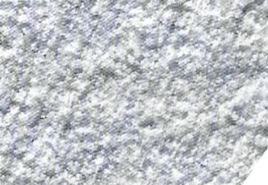
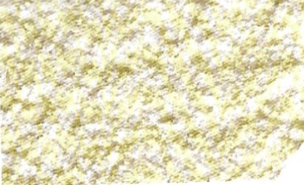


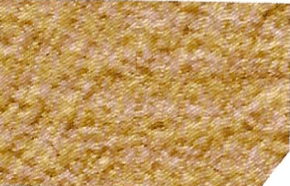


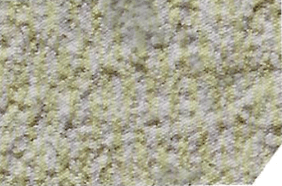
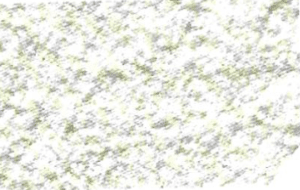
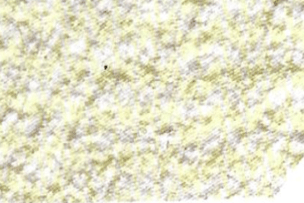
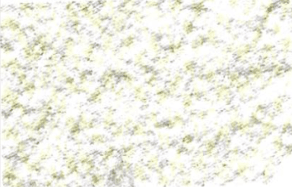
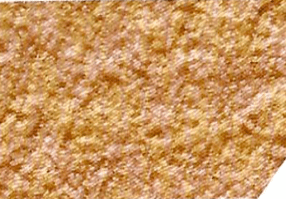

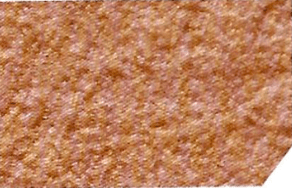
In our exploration of coloured render, monocouche stands as a testament to efficiency and functionality, making it a practical choice for those seeking a cost-effective yet visually stunning exterior coating. As we delve into other types of coloured render, each presents its own unique characteristics, catering to diverse preferences and architectural requirements.
You can find out more about our monocouche render service here.
Silicone-Based Coloured Render
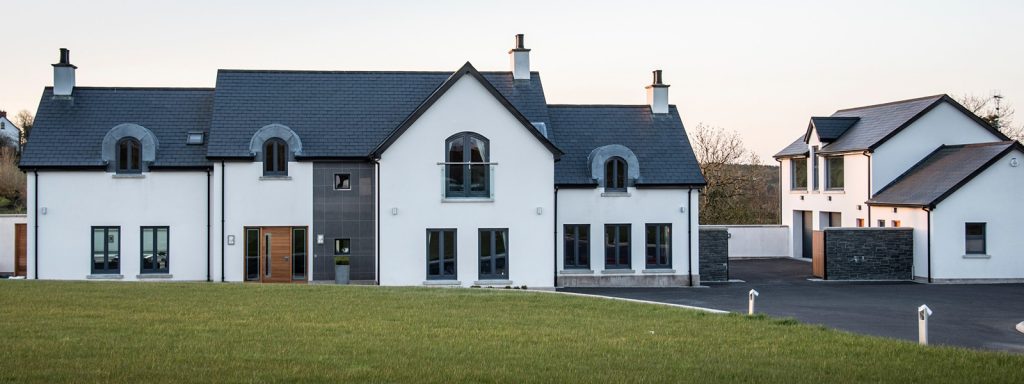
Silicone render stands out as a versatile and advanced solution in the realm of coloured render, offering enhanced water repellency and a modern finish. There are two primary types, each catering to specific preferences and applications.
Scrapped Silicone Texture
Description
This type of silicone render shares similarities with monocouche in its application method. After application, the render is scraped to create a textured finish, providing depth and character to the exterior surface. It offers a range of standard colours, and special colours can be obtained through customisation.
Characteristics
Suitable for both hand and machine application.
Water repellent, durable, and resistant to algae growth.
Options for achieving special effects, such as a brick or stone-like finish.
Recommended Product: K Rend’s Scraped Texture range, available in 20 standard colours with additional special colours upon request.
Silicone Scraped Render Colours
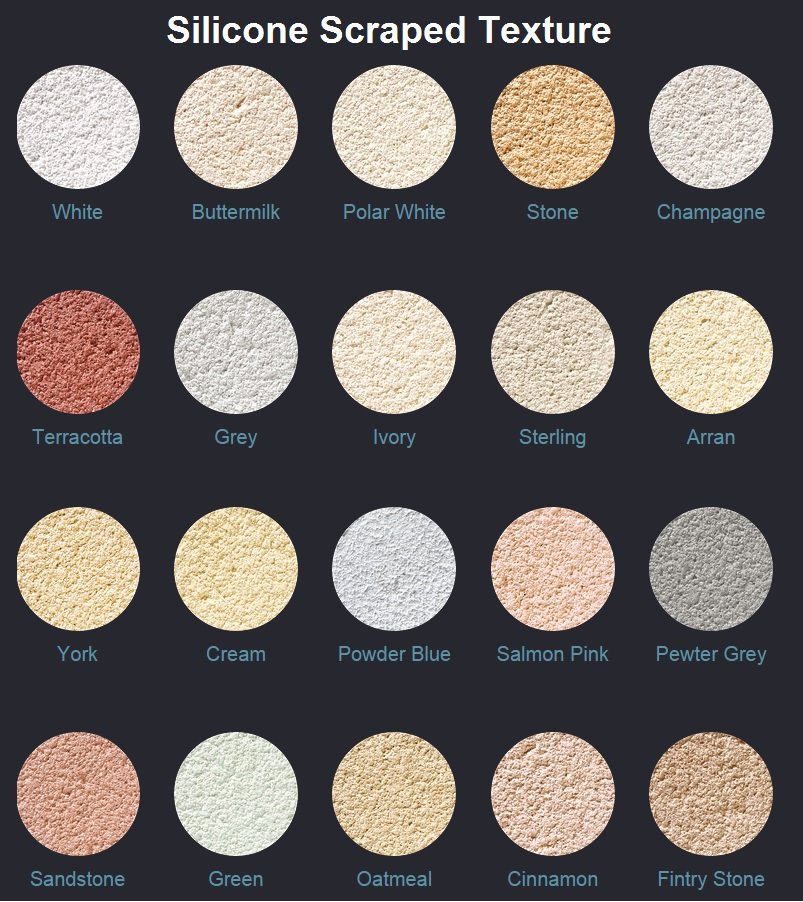
Thin Coat Silicone Render
Description
Our most popular silicone render product, the thin coat silicone render, sets itself apart with its application on board systems or directly onto masonry. The curing time for this render is shorter than its scraped counterpart, offering efficiency in both time and labour. The thin coat render produces a different finish compared to the scraped silicone render range and its texture can be modified slightly by adjusting application thickness.
Characteristics
Applicable to board systems or masonry directly.
Water repellent, durable, and resistant to algae growth.
Water repellent, durable, and resistant to algae growth.
Versatility in texture modification through different application thicknesses.
Recommended Product: Johnstones or K-Rend Thin Coat Silicone Render, available in a wide range of standard colours, with additional special colours upon request.
Both types of silicone render share common benefits, such as superior water repellency and durability. However, the choice between the scraped texture and thin coat silicone render depends on specific project requirements and aesthetic preferences.
The thin coat silicone render, with its efficiency and adaptability, stands as a popular choice for many projects, showcasing the continuous evolution and innovation within the realm of coloured render.
Considerations
Curing Time: The curing time of silicone render is longer compared to monocouche, impacting labour time during application.
Crack Resistance: Similar to monocouche, silicone render is not inherently crack-resistant, making it less suitable for properties prone to movement.
In selecting silicone-based coloured render, property owners benefit from a blend of modern aesthetics and robust functionality. Its water-repellent technology, design versatility, and durability position it as a preferred choice for those seeking a resilient and visually appealing exterior coating.
As we continue our exploration of coloured render options, each variant unfolds its own set of features and considerations, catering to a spectrum of architectural preferences and requirements.
You can find out more about our silicone render service here.
Thin Coat Silicone Render Colours
Acrylic or Resin-Based Coloured Render
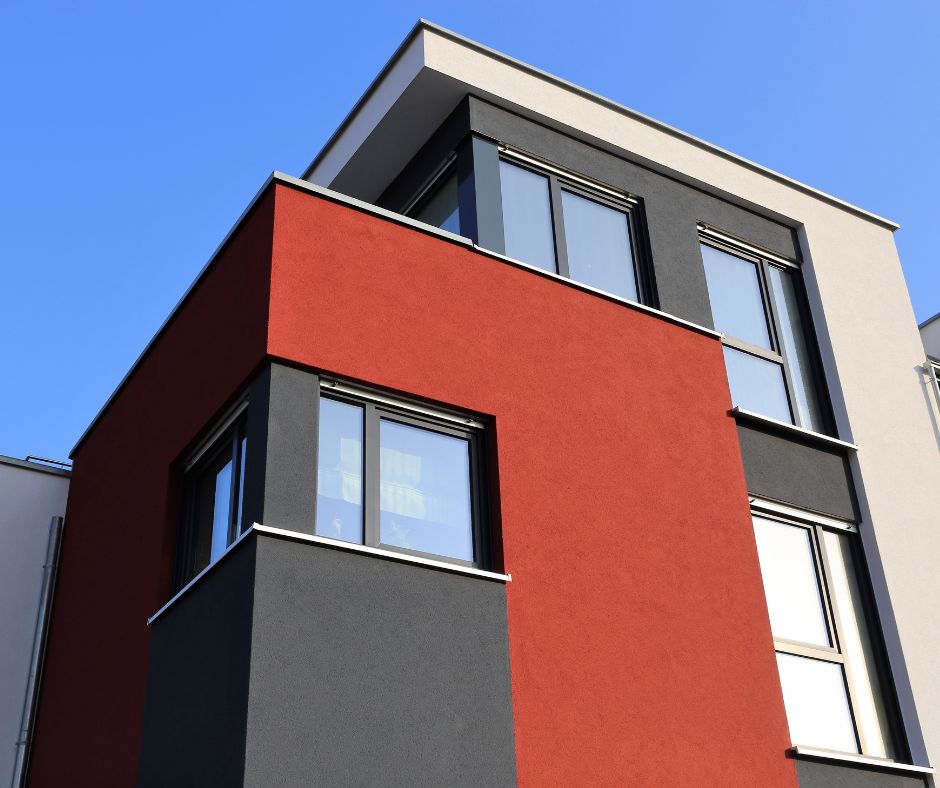
Acrylic render, a distinctive member of the coloured render family, represents a resilient and flexible solution that combines weather resistance with design versatility. Formulated as a resin-based render system, acrylic render offers a durable exterior coating suitable for various applications, with the added flexibility to achieve a range of textures and finishes.
Key Characteristics
Weather Resistance: Acrylic render is recognised for its resistance to varying weather conditions, making it an ideal choice for exterior surfaces exposed to the elements.
Flexibility: Due to its resin-based composition, acrylic render exhibits flexibility, reducing its susceptibility to cracking—a valuable characteristic for maintaining the integrity of the render over time.
Application Surfaces: While often applied on approved render board systems, acrylic render can also be directly applied onto masonry, providing versatility in its use.
Colour Options: Offering a vast spectrum of colours, acrylic render allows property owners to explore darker and stronger hues that may not be achievable with other render types.
Design Options and Considerations
Texture Variety: Acrylic render can be finished with different textures, offering property owners the option to tailor the finish to their aesthetic preferences.
Condensation Consideration: It’s important to note that, unless mixed with other materials, acrylic or resin renders may not allow the property to breathe. This consideration is crucial to avoid potential condensation issues.
Recommended Manufacturer and Colours
Manufacturer: Parex is our recommended manufacturer for acrylic renders, known for delivering quality products.
Colour Range: Parex offers an extensive range of colors, allowing property owners to explore a myriad of design possibilities.
Choosing acrylic render involves balancing weather resistance, flexibility, and design freedom. Its ability to resist cracking, coupled with the option to explore a broad colour palette, positions acrylic render as a compelling choice for those seeking a durable and aesthetically pleasing exterior coating.
As we continue our exploration of coloured render options, each type unveils its unique characteristics, providing tailored solutions for diverse architectural preferences and project requirements.
You can find out more about our acrylic render service here.
Minder-Based Renders
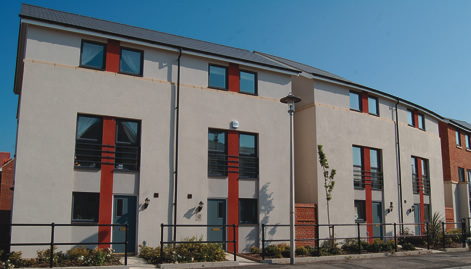
Mineral-based renders emerge as a practical solution, especially in circumstances where adverse weather conditions or low temperatures pose challenges to traditional rendering methods. These modern renders, whether coloured or not, offer rapid drying times and enhanced durability, making them suitable for a variety of exterior applications.
Key Characteristics
Quick Drying: One of the standout features of mineral-based renders is their rapid drying time. This makes them particularly advantageous when dealing with lower temperatures or adverse weather conditions during application.
Coloured or Non-Coloured Options: Mineral-based renders provide the flexibility of being both coloured and non-coloured, catering to different aesthetic preferences and project requirements.
Dirt Resistance: Depending on the manufacturer, these renders may be mixed with additional properties to enhance dirt resistance, contributing to a cleaner and more aesthetically pleasing finish.
Weather-Dependent Application
Colder Climate Advantage: The quick-drying nature of mineral renders makes them a practical choice for colder climates or instances where adverse weather conditions might impede the application of other render systems.
Less Prone to Wash Off: The fast-drying property also makes them less prone to wash off, a common issue encountered with slower-drying renders in wet conditions.
Considerations
Application Conditions: While ideal for colder climates, the specific application conditions—such as temperature and humidity—may vary by manufacturer. It’s crucial to adhere to recommended guidelines for optimal results.
The versatility of mineral-based renders becomes evident, particularly in scenarios where traditional rendering methods might face challenges. Whether coloured or non-coloured, these renders offer a practical and efficient solution, emphasising both quick application and durable, weather-resistant finishes.
Each type of coloured render introduces a distinct set of advantages, contributing to a comprehensive array of options for property owners and architects seeking the ideal exterior coating solution.
Coloured Render Options and Finishes
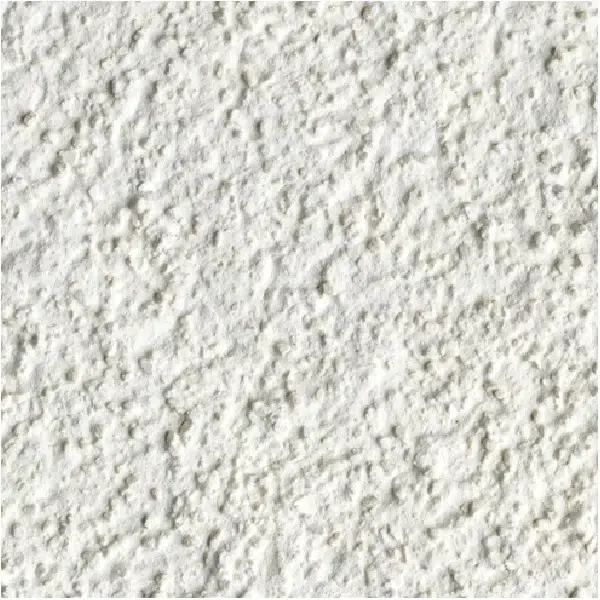
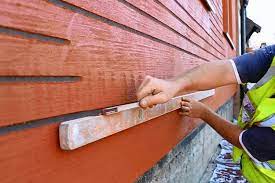
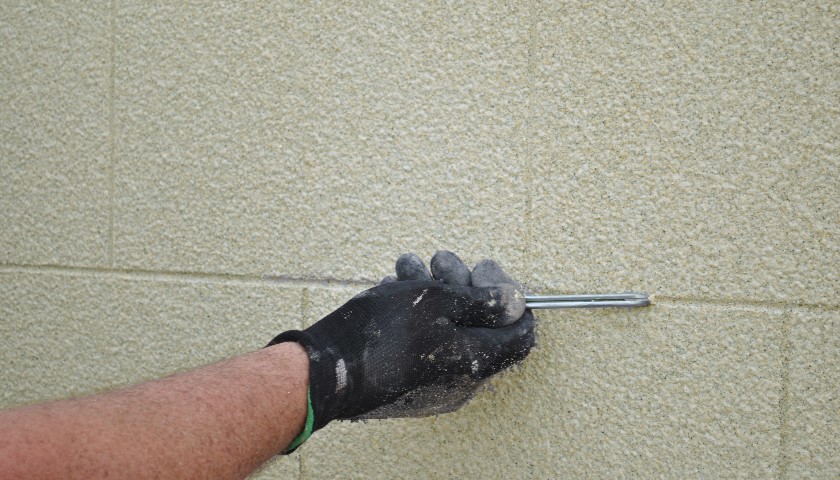
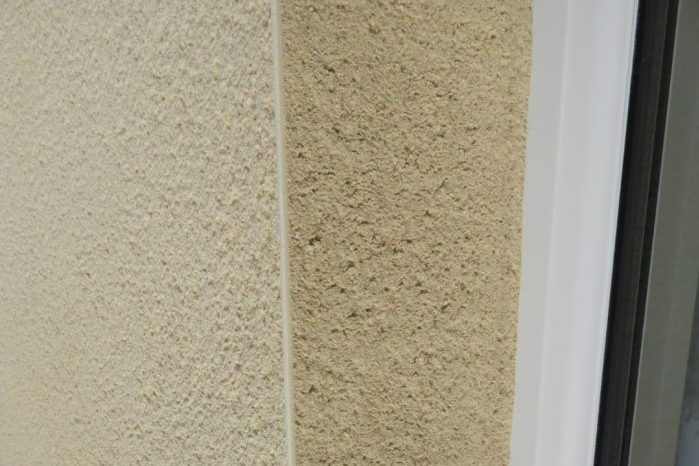
Coloured render opens up a realm of possibilities for property owners and architects, providing a diverse palette of options to enhance the visual appeal of exteriors. Beyond the traditional notion of rendering, these modern solutions allow for creative expression through various finishes and effects.
Monocouche Finishes
Flat and Pitted Appearance: Monocouche render, known for its one-coat application, delivers a flat finish with a pitted appearance that surpasses the traditional rendering aesthetic. The application versatility enables hand or machine application, offering efficiency without compromising quality.
Special Effects: Despite being a one-coat system, monocouche render is not limited in its potential. Using specialised products and application technique it can achieve special effects, including mimicking the appearance of brick or ashlar stone, providing an array of design possibilities.
Silicone-Based Finishes
Scraped Texture Range: Silicone-based render introduces a scraped texture range, combining durability with a subtle textured finish. This range is available in 20 standard colours, offering a versatile selection for exterior applications.
Thin Coat Renders: For those seeking a different look, thin coat renders present an alternative finish. Applicable to board systems or masonry, thin coat renders offer a distinct texture that can be modified to taste by adjusting the thickness of the application.
Acrylic Render Finishes
Weather-Resistant Textures: Acrylic render, with its weather-resistant properties, provides options for various textures. Whether applied on approved render board systems or directly on masonry, acrylic render allows for design flexibility while maintaining durability.
Darker Hues: A notable characteristic of acrylic render is its ability to achieve darker and stronger colours, expanding the spectrum of design possibilities.
Mineral-Based Finishes
Coloured or Non-Coloured: Mineral-based renders offer versatility in being both coloured and non-coloured, accommodating different project requirements. This flexibility extends to the finish, providing options for varied aesthetic preferences.
Dirt-Resistant Options: Some manufacturers mix additional properties into mineral renders to enhance dirt resistance, contributing to a cleaner and aesthetically pleasing finish.
Coloured render is not a one-size-fits-all solution; it’s a canvas waiting for expression. Whether you prefer the clean lines of monocouche, the textured allure of silicone-based renders, the weather-resistant flexibility of acrylic, or the quick-drying efficiency of mineral-based options, each type offers a distinct set of finishes and design potentials.
As we navigate through these coloured render options, it becomes clear that the beauty lies not only in the colour but also in the multitude of ways these finishes can transform the visual identity of your property.
Popular Colours and Trends
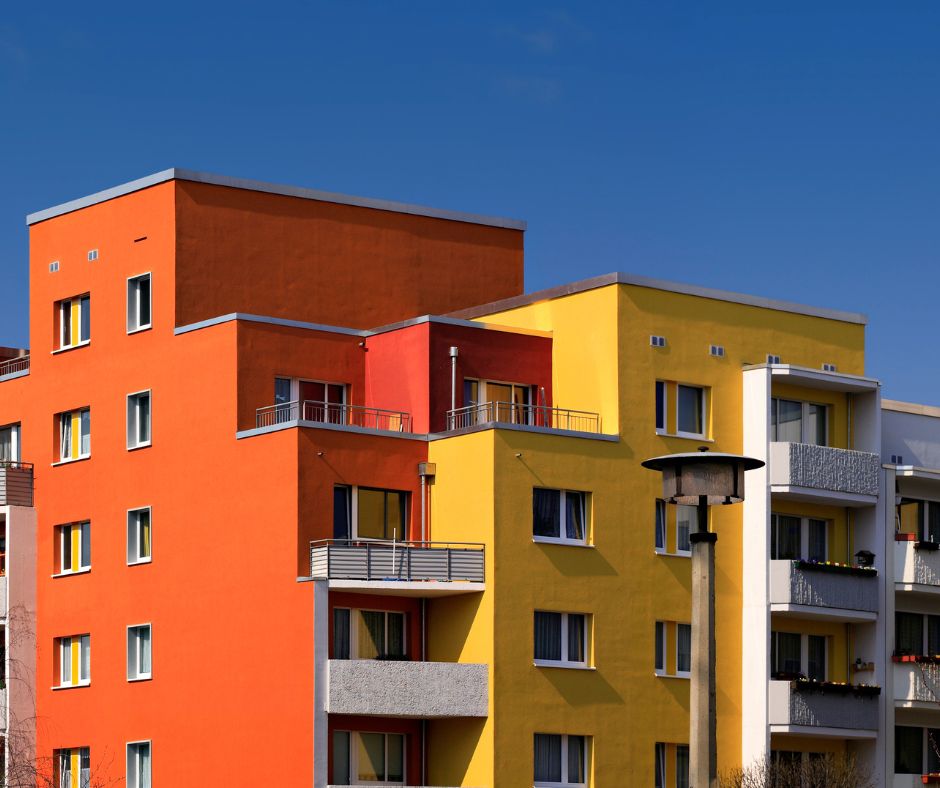
Coloured render not only provides a protective layer for your property but also serves as a dynamic element for aesthetic expression. Over the years, certain colours and trends have gained popularity, reflecting evolving tastes and design preferences in the realm of exterior coatings.
Vibrant Statements
Bold and Bright: Schools, hospitals, and public buildings often embrace vibrant, bold colours to make a statement. These hues inject cheerfulness into the architectural landscape and stand as a testament to the versatility of modern coloured renders.
Residential Elegance
Subtle and Timeless: For residential properties, subtle and timeless colours often take center stage. Shades like Ivory, Light Grey, Chalk, and Silver Pearl have emerged as enduring choices, providing a refined and elegant appearance that complements a variety of architectural styles.
Mimicking Natural Elements
Earthy Tones: Coloured render opens the door to mimicry, allowing properties to adopt the appearance of natural elements such as brick or stone. This trend seamlessly blends modern construction with classic aesthetics.
Individualised Projects
Customised Palettes: With a broad spectrum of colours available from manufacturers, property owners are increasingly opting for customised palettes. This trend emphasises the desire for unique, individualised projects that reflect personal tastes.
Texture Variation
Textured Finishes: Beyond colour, the texture of the render plays a pivotal role in design. The popularity of textured finishes, whether achieved through scraped silicone renders or specialised application techniques, introduces a layer of tactile interest to exteriors.
Environmental Tones
Natural Greens and Blues: As environmental consciousness grows, there’s a rising interest in incorporating natural greens and blues. These tones not only connect the property with its surroundings but also contribute to a harmonious integration with nature.
Considerations
Architectural Harmony: When selecting colours, it’s crucial to consider the overall architectural context. Harmonising with the surroundings and architectural style ensures a cohesive and visually pleasing result.
Long-Term Appeal: While trends may influence initial choices, opting for colours with long-term appeal contributes to the enduring beauty of the property.
Understanding popular colours and trends is valuable, but the ultimate decision rests on the unique character and vision for each property. Whether embracing bold statements, timeless elegance, or environmentally conscious hues, coloured render provides a canvas for creative expression, ensuring that your property stands out with individuality and style. As we navigate the landscape of coloured render, let these trends inspire, but also let your personal vision guide the choice that transforms your property into a unique masterpiece.
Considerations and Downsides

While coloured render presents an array of benefits and design possibilities, it’s important to navigate the decision-making process with a clear understanding of considerations and potential downsides. Each type of coloured render comes with its own set of factors that should be carefully weighed to ensure a choice that aligns with both aesthetic preferences and practical requirements.
Cost Considerations
Initial Investment: Coloured render, compared to traditional sand and cement render, often comes with a higher initial cost. However, it’s essential to view this as an investment in long-term durability and reduced maintenance.
Property Suitability
Crack Resistance: Not all coloured renders are inherently crack-resistant. Properties prone to movement may require careful consideration to choose a render type that minimises the risk of cracking.
Breathability: Some acrylic or resin-based renders may not allow the property to breathe, potentially leading to condensation issues. It’s vital to align the choice of render with the specific needs of the property.
Maintenance Implications
Low Maintenance, Not No Maintenance: While coloured render is generally low maintenance and eliminates the need for frequent repainting, it’s not entirely maintenance-free. Periodic inspections and cleaning may still be necessary to ensure the longevity of the render.
Colour Fading
Exposure to Elements: Over time, exposure to sunlight and the elements can lead to gradual colour fading. Choosing high-quality pigments and finishes can mitigate this effect, but it’s essential to be aware of the potential for changes in appearance.
Repairs and Challenges
Challenges in Coloured Render Repairs: While coloured render boasts durability and low maintenance, repairs pose a unique set of challenges. Achieving a seamless match in both texture and colour during repairs, even with specialised skills and using the same batch of products, can be intricate.
The pigmentation throughout the material makes it particularly challenging to render an invisible repair as does matching the texture. It is highly probable that certain lights may reveal distinctions between existing and repaired sections. Ideally, the most effective way to ensure a perfect finish and minimise the risk of visible differences in texture and colour is to redo a whole section rather than try to patch a small area.
Property owners should be aware of these challenges and understand that even if the repair area only seems to be a small patch to achieve a flawless finish it may be necessary to redo the entire wall.
Architectural Compatibility
Architectural Style: The architectural style of a property should be considered when choosing coloured render. Harmonising the render with the existing aesthetics ensures a seamless integration rather than a visually jarring contrast.
Professional Advice
Consultation: Before making a final decision, seeking professional advice is paramount. A consultation with a qualified expert can provide insights into the specific needs of your property, ensuring the chosen coloured render aligns with both aesthetic and structural requirements.
Local Climate
Climate Considerations: The local climate plays a significant role in the performance of coloured render. Understanding how the chosen render type responds to temperature variations, humidity levels, and exposure to the elements is crucial for long-term durability.
How much does coloured render cost?: Pricing Overview

Understanding the costs associated with coloured render applications is crucial for budgeting and decision-making. Here is a general pricing guide for our services:
Monocouche Render
Price Range: Monocouche render is priced at approximately £80 – £90 per square meter, covering both labour and materials.
Silicone, Acrylic, and Mineral Render
Price Range: Silicone, acrylic, and mineral render services are estimated to range from £80 – £120 per square meter, inclusive of both labour and materials.
Please note that these figures are indicative and serve as a general guide. The actual cost of the coloured render application can vary based on several factors:
Price Variation Factors
Product Choice: The selection of a specific render product and manufacturer, whether it’s silicone, acrylic, or mineral-based, can influence the overall cost due to variations in material prices.
Finishes and Textures: Opting for special textures or effects like brick or stone finishes, may incur additional costs.
Colour Choices: The choice of colours can also impact pricing. None standard range colours, especially mixed custom or bold options, might involve additional costs.
These variables, along with considerations like the substrate, preparation work, base coat requirements, scaffold installation, and the removal of old render, collectively contribute to the final project cost.
For accurate and personalised pricing, we encourage you to connect with our team. We consider the unique requirements of each project to provide detailed and competitive pricing tailored to your specific needs.
Top-Quality Materials, Trusted Techniques
At P3 Plastering, we’ve teamed up with leading manufacturers such as Weber, Parex, Johnstones, and K-Rend. This collaboration ensures that we use premium materials in every project, resulting in enduring quality, weather resistance, and exceptional finishes.
Our team can offer advice into product selection, finishes, and colour choices that might affect your overall investment in achieving the perfect coloured render for your property. Get in touch today.
Frequently Asked Questions about Coloured Render

What is coloured render, and how does it differ from traditional render?
Coloured render, also known as through coloured render, is a type of modern exterior coating that incorporates colour pigments during the manufacturing process. Unlike traditional render, where colour is applied as a topcoat, coloured render is pigmented all the way through the material, providing lasting colour and eliminating the need for frequent painting.
What are the benefits of using coloured render for my property?
Coloured render offers numerous benefits, including low maintenance, durability, and added weather protection. It eliminates the need for frequent repainting, is algae and water-resistant, and provides options for special effect finishes. Each type of coloured render, such as monocouche, silicone-based, acrylic, or mineral-based, comes with its own set of advantages.
Is coloured render suitable for all types of properties?
While coloured render is suitable for a wide range of properties, it’s essential to consider factors such as the type of property, the local climate, and the desired aesthetic. Some renders may not be crack-resistant or suitable for properties prone to movement, so it’s crucial to choose the right type based on individual property characteristics.
How long does coloured render last, and does it fade over time?
Coloured render is known for its longevity, and the duration it lasts depends on factors like the type of render and environmental conditions. While exposure to sunlight and the elements may cause gradual colour fading over time, choosing high-quality pigments and finishes can mitigate this effect.
Can I achieve special effects or different textures with coloured render?
Yes, coloured render allows for creative expression with various textures and special effects. Monocouche, some silicone-based, and acrylic renders can be applied to achieve finishes like brick or stone. The texture can also be modified to taste by adjusting the thickness of the application.
How do I choose the right colour for my property?
Selecting the right colour involves considering the architectural style, surrounding environment, and personal preferences. Popular choices for residential properties often include subtle and timeless colours like Ivory, Light Grey, Chalk, and Silver Pearl. It’s recommended to request samples and consult with experts for a better understanding of how the chosen colour will appear on your property.
Is coloured render more expensive than traditional render?
Coloured render typically comes with a higher initial cost compared to traditional sand and cement render. However, it’s crucial to view this as an investment in long-term durability and reduced maintenance. Over the lifetime of the render, the additional expense is often recouped through savings on painting and maintenance.
Can I apply coloured render myself, or do I need professional help?
While some coloured renders offer DIY application options, achieving a professional finish often requires expertise. It’s advisable to consult with experienced render specialists or contractors who can provide guidance on the application technique and ensure a successful outcome.
How do I maintain coloured render, and is it prone to cracks?
Coloured render is generally low maintenance, but periodic inspections and cleaning may be necessary to ensure its longevity. The susceptibility to cracks depends on the type of render, and some renders may not be crack-resistant. Choosing the right type based on the property’s characteristics is essential to minimise the risk of cracking.
Can coloured render be applied in colder climates or during wet conditions?
Certain types of coloured render, like mineral-based renders, are particularly useful in colder climates or adverse weather conditions due to their quick-drying nature. It’s important to follow recommended guidelines and, in some cases, mix additional properties to enhance resistance to issues like wash off.
Coloured render undoubtedly offers an impressive array of benefits, but a well-informed decision is key to a successful outcome. By carefully weighing cost considerations, understanding the specific needs of the property, and seeking professional advice, property owners can navigate the potential downsides and ensure that the chosen coloured render not only enhances the visual appeal of the property but also stands the test of time.
Professional Advice and Further Information
Choosing the right coloured render for your property is an important decision that requires careful consideration of various factors. Seeking professional advice is a crucial step in ensuring that your choice aligns with both aesthetic preferences and the unique characteristics of your property. Below are a few of our professional tips to help you navigate the world of coloured render with confidence.
Our Top Tips

Tip #1: Consultation with Experts
Engaging with architects or designers with expertise in exterior finishes can provide valuable insights. They can assess the architectural style of your property and recommend coloured render options that seamlessly integrate with the overall design.
Tip #2: Experienced Renderers
Consulting with experienced render specialists or contractors who have a track record in applying coloured render systems is essential. Their practical knowledge can guide you through the intricacies of application, ensuring a successful outcome.
Tip #3: Manufacturer Guidance
Manufacturers of coloured render products often have representatives who can offer detailed information about their specific products. They can provide guidance on application techniques, recommended surfaces, and maintenance procedures.
Tip #4: Local Climate Considerations
For properties in diverse climates, consulting with experts who understand the local weather patterns is advisable. They can offer recommendations based on how different types of coloured render perform in specific climatic conditions.
Tip #5: Research and Further Reading
Delving into further research through reputable online resources can broaden your understanding of coloured render options. Manufacturer websites, industry publications, and case studies can provide additional information to support your decision-making.
Tip #6: Visit Completed Projects
If possible, visiting properties where coloured render has been successfully applied can offer firsthand insights. Observing completed projects allows you to witness the durability, finish quality, and overall impact of different render types.
Tip #7: Requesting Samples
Many manufacturers provide sample kits that include small render sections showcasing their product’s colours and textures. Requesting these samples allows you to physically assess how a particular coloured render will appear on your property.
Tip #8: Stay Informed
Attending industry events, workshops, or seminars related to exterior finishes can provide opportunities to interact with professionals, learn about emerging trends, and stay informed about advancements in coloured render technology.
Disclaimer: The information provided in this guide on coloured render is intended for general informational purposes only. While we strive to present accurate and up-to-date information, the field of rendering is diverse, and individual projects may have unique requirements.
Coloured render applications involve various factors, and the content provided here should not be considered a substitute for professional advice. Every property is unique, and decisions about coloured render should be based on a thorough evaluation of specific needs, local conditions, and expert consultation.
We strongly recommend seeking personalised advice from qualified professionals to ensure that the information presented aligns with the specific characteristics of your property. The decision to choose coloured render involves multiple considerations, and professional guidance will help tailor solutions to your project's requirements.
P3 Plastering and the authors of this guide do not assume any responsibility for decisions made based on the information provided. Always consult with experienced professionals to receive accurate and tailored advice for your coloured render project.Conclusion: Elevating Your Property with Coloured Render

As we conclude this guide on coloured render, remember that as well as understanding the benefits of coloured render it is also important to know its constraints. Seeking professional advice is an invaluable asset in making an informed decision. Whether consulting with experts, visiting completed projects, or staying abreast of industry developments, taking the time to gather comprehensive information will empower you to choose a coloured render that not only enhances the beauty of your property but also withstands the test of time.
For further information and insights, explore our website or contact our team for personalised assistance. If you are located within one of our service areas listed below then we offer a free no obligation render evaluation. At this consultation we will assess the suitability of your property and answer any questions you may have. We will also bring along some samples for you to see.
Book A Render Evaluation
Our main service areas are:

